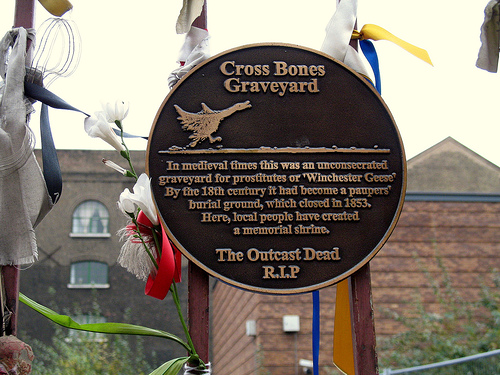Cross Bones Graveyard – Southwark
The City of London has had a long and colourful history; the people that lived here across the centuries have ranged from the impossibly rich to the impoverished poor, but all of them had one thing in common, the church. They were welcomed into the arms of the church at birth and dispatched at death into the consecrated grounds of the many churchyards that litter the city. That is providing of course, that they lived their lives free from sin. For those on whom the church turned their back on they were left with a different resting place.

Un-consecrated Memorial to the Forgotten
In the SE1 area of London, along the quiet and unassuming backstreet of Redcross Way, you will come upon a large and seemingly vacant plot of land. This piece of urban greenery is actually Cross Bones Graveyard and is the resting place of countless bodies to those who were forbidden from being buried within consecrated grounds. This plot was originally established towards the late medieval era to house the bodies of the hundreds if not thousands of prostitutes that plied their trade in the area, what was once one of the most dark and lawless in all of London. As the land here belonged not to the City of London, but instead to the Bishop of Winchester the ladies that plied their trade in its dirty streets were locally referred to as ‘Winchester Geese’. The cemetery was originally given the name of the ‘Single Woman’s Churchyard’ although of course, there is no church adjacent to the plot.
Sordid Southwark
As the years passed the cemetery also became the site of many pauper burials and the final resting place of the homeless and transient section of society, as well as the criminal classes. This part of London was a true den of iniquity and its many legalised unsavoury diversions such as bull and bear baiting, as well as dog and cock fighting, and the many theatres and hostelries led to it being described as London’s ‘Pleasure Garden’. With so many of societies undesirables flocking to the area the cemetery was soon filled to capacity, and was abandoned around 1850 due to serious health and safety concerns.
Unsavoury Excavations
In 1992 as part of the work on the extension of the Jubilee Underground Line the Museum of London undertook an excavation at the cemetery. They found that body after body lay unceremoniously piled on top of another, making it more of a mass grave than a graveyard proper. In total they excavated 148 graves which all dated between 1800 and 1853. One shocking discovery was that over half of the population of the cemetery was under five years of age at the time of their death, making for a staggeringly high infant mortality rate at that time. The plot was beyond overcrowded placing the surrounding area, at the time the cemetery was in use at serious risk of disease. The main causes of death cited for the excavated dead were smallpox, rickets, scurvy and tuberculosis a clear indication of just how sordid this ‘Pleasure Garden’ actually was.

